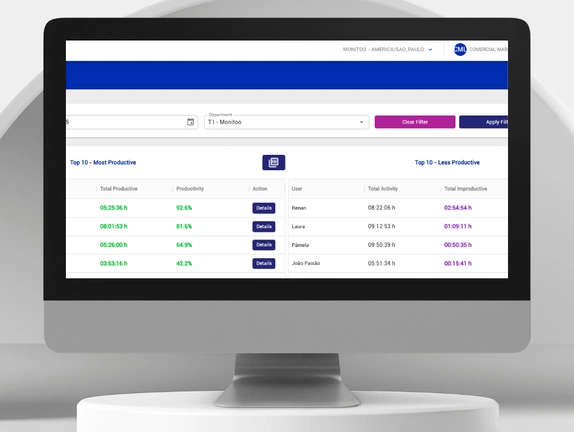Productivity , Home Office , Efficiency
06 de June de 2025 - 16h06m
ShareProductivity is one of the most important pillars of modern business competitiveness.
In a scenario where remote, hybrid, and digital work have become the norm, interpreting productivity reports has ceased to be a differential and has become a strategic necessity.
More than just measuring how much time employees are connected, productivity reports help understand how work is being performed, which processes are optimized, and where bottlenecks exist.
With the support of intelligent tools like Monitoo, this analysis can be done precisely, ethically, and in real time.
This complete guide explores how to interpret these indicators efficiently to transform data into more assertive managerial decisions.
Productivity reports are tools that transform operational data into business intelligence. They reveal not only the "how much" work is done, but the "how" and "with what quality." Continuous monitoring allows you to:
Companies that master the interpretation of these reports manage to create result-oriented organizational cultures while promoting more balanced and productive environments.
Productivity Score: At Monitoo, the score is calculated based on the workday divided into four categories: Productive, Unproductive, Neutral, and Undefined. This allows for a granular performance analysis.
Hours Worked vs. Productive Hours: Not all recorded hours are necessarily productive. Distinguishing between worked time and truly productive time helps identify gaps and create optimization strategies.
Idle Time Control: Monitoring inactivity periods helps detect possible overloads, demotivation, or problems in task distribution.
Activity History: Reports detailing websites and programs used reveal behavioral patterns. This helps promote healthy digital habits and eliminate distractions.
Correct interpretation requires more than looking at numbers. Context, critical analysis, and an integrative vision are necessary.
Monitoo is a robust platform that facilitates report generation, reading, and interpretation. Its main features include:
These features make reports more precise and tailored to each business reality.
The true utility of reports lies in how they are used. Here are some examples:
It is essential that monitoring respects ethical boundaries. Monitoo guarantees that nothing typed or displayed on the screen is captured, fully respecting employee privacy.
Transparency and clear communication with the team are crucial to creating a trusting environment, even with continuous data analysis.
Companies using Monitoo have reported:
These data show that efficient interpretation of reports generates measurable and impactful results.
Productivity reports are more than operational documents. When well interpreted, they guide strategies, optimize processes, and promote data-driven and trust-based management.
Tools like Monitoo make this process accessible, ethical, and highly effective.
👉 Try Monitoo free for 7 days and discover how to transform your management with real-time data.
👉 Request a personalized demo.
